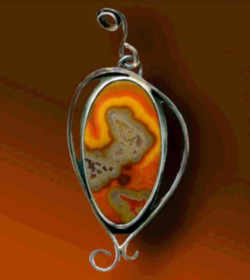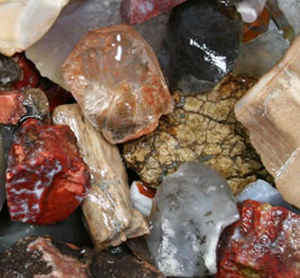
Kentucky Symbols
Kentucky State Rock
Kentucky Agate

(SiO2)
Adopted on July 14, 2000.
On July 14, 2000, agate was officially designated as Kentucky's state rock (Kentucky Acts ch. 146, sec. 1).
These sharp-angled bands resemble the outlines of fortifications of a castle.
This might be confusing, because scientifically agate is considered a variety of the mineral quartz. Minerals are the building blocks of rocks. Agate is considered both a mineral (cryptocrystalline quartz) and a rock, and is formed by chemical precipitation from silica-rich solution in rock cavities. Often characterized by bands of spectacular colors, agate with bright red bands of color found in Kentucky is prized by collectors, and is called Kentucky Agate.
Although rocks are generally thought of as sedimentary, metamorphic, and igneous types, collectors and hobbyists call varieties of some minerals rocks as well. Quartz has many varieties. Naturally occurring chemical impurities in the quartz can cause it to be colored. When different impurities occur in bands within quartz, the quartz will have a colorful, banded appearance, and it is then called agate.
Kentucky State Rock: Kentucky Agate

The Kentucky Geological Survey was not consulted prior to this designation, which is unfortunate, because although beautiful agates are found in Kentucky, agate is scientifically a variety of the mineral quartz, and not a rock. Minerals are the building blocks of rocks. Rocks are composed of many minerals and are formed through sedimentary, igneous, or metamorphic processes, which, strictly speaking, agate is not. Now Kentucky has a state rock that is really a mineral, and a state mineral (coal) that is really a rock!
Agate, a microscopically crystaline form of quartz, a silicate mineral, has delicate and varying shades of color arranged in layers. In the typical occurrence the bands are irregular, curved, or in concentric patterns. Agate is used as an ornamental material or in semi-precious jewelry. The color banding is usually related to chemical impurities; for example, iron gives a red or orange color and manganese or calcium give black or blue colors.
Beautiful specimens of red, black, yellow, and gray banded agate have been discovered in Estill, Jackson, Powell, Madison, and Rockcastle Counties. These "Kentucky Agates" are derived from the Borden Formation of Early Mississippian age and can be collected along some river drainages where the Borden is exposed to weathering. Many of these agates are displayed at local rock shows.
AGATE, a banded variety of Chalcedony
VARIETY INFORMATION:
VARIETY OF: Crypto-crystalline Quartz , SiO2
USES: Gemstone and ornamental stone.
COLOR: Nearly any color, even colorless. The key is the presence of banding
HARDNESS: 7
CLEAVAGE: none
CRYSTAL SYSTEM: none visible (actual crystals are microscopic)
What is an Agate?

Agates are semi-precious gemstones that are a variegated form of chalcedony, which is silicon dioxide in the form of microscopic fibrous quartz crystals. Agates naturally develop when an empty pocket inside a host rock fills in molecule-by-molecule, layer-by-layer as these microcrystals self organize to form concentric bands or other patterns. The colors and arrangement of the microcrystals are influenced by changes in pressure, temperature, and mineral content that occur during the formation process. Unlike other gemstones, each agate is unique. Even slabs cut from the same specimen will vary in color and design.
How do Agates form?
Agates develop as secondary deposits in hollow cavities, called vesicles. Although they can form in all types of host rock, most of the world's agates developed in ancient volcanic lava. When the continents were first forming, layers of molten lava pushed toward the earth's surface through rift zone cracks, volcanoes, and other geologic events. Within the lava, there were pockets of trapped gases. Later, these gases escaped through cracks that formed as the igneous rock cooled and hardened, leaving hollow cavities. Other cracks and seams also formed when adjoining sections of lava cooled at different rates.
These empty cavities and seams filled with fluids rich in dissolved and suspended quartz molecules (silica), as well as other mineral impurities. When the silica concentration became supersaturated, it developed a gelatin-like consistency either throughout the pocket or in a layer that served as the active crystallization front. Over time, the silica molecules began to form miniature fibrous microcrystals that attached to the sides of the cavity or seam. During the filling-in process other mineral impurities collected at the inside of the chalcedony silica band, forming intervening and often contrasting bands. This pattern repeated until the entire vesicle was filled in, or until all the silica rich solution was used up. If there was the proper balance of silica and mineral impurities, then the entire cavity filled with alternating bands. If there was an insufficient quantity of mineral impurity or if the pressures and temperatures changed, the cavity completed filling in with macrocrystalline quartz, or another form of silica.
Folklore

Agate Gemstone meaning
This is THE stone everyone should have for protection. This group of stones are variegated chalcedony. (see also moss agate, eye agate) The agate is
one of the oldest stones in recorded history.
Agates attract strength. Agate is a protection from bad dreams. It also protects from stress and energy drains. Agates have been used in jewelry since
Biblical Babylonian times. They were used to ward off storms. They were prized gems in antiquity. The agates with banded colors were placed at the
head of a sleeper to give rich and varied dreams. Agates have been thought to be good to harden the gums.

Healing properties of agate
Agate is used for stomach upsets. Place the agate on the solar plexus. The agate can't change emotions, but helps to change our level of acceptance
of the emotion. Such as when you are very sad the agate will let you know that this will pass and help you get on to another and better day. This is
why the Agate is considered so powerful as it gives us the strength to carry on. Carry an agate when you have to make an important decision.
Kentucky House Bill 123
(BR 318) - J. Bowling, J. Adams, R. Adkins, S. Alexander, J. Arnold Jr., A. Arnold, B. Ausmus, III, E. Ballard, S. Baugh, C. Belcher,
L. Belcher, I. Branham, K. Bratcher, B. Buckingham, T. Burch, De. Butler, Dw. Butler, J. Callahan, P. Childers, L. Clark, B. Colter, J. Crenshaw, R.
Damron, B. DeWeese, J. Draud, J. Fischer, J. Gooch, G. Graham, J. Gray, B. Heleringer, C. Hoffman, J. Hoover, D. Horlander, S. Johns, E. Jordan, M.
Marzian, T. McKee, C. Miller, L. Napier, F. Nesler, R. Palmer, R. Palumbo, M. Rader, T. Riner, A. Simpson, J. Stacy, K. Stein, G. Tapp, R. Thomas,
M. Treesh, J. Turner, K. Upchurch, C. Walton, J. Wayne, M. Weaver, R. Wilkey, P. Worthington, B. Yonts
AN ACT relating to the designation of the official rock of Kentucky.
WHEREAS, the colorful rock, Kentucky agate, bears the name of this great Commonwealth; and
WHEREAS, this beautiful Kentucky resource, characterized by delicate bands of blue, red, orange, black, yellow, or gray shades, is often displayed
at local rock shows and used as an ornamental material and in semiprecious jewelry; and
WHEREAS, designation of a state rock will promote interest in geology, the hobby of mineral collecting, and the lapidary arts;
NOW, THEREFORE,
Be it enacted by the General Assembly of the Commonwealth of Kentucky:
SECTION 1. A NEW SECTION OF KRS CHAPTER 2 IS CREATED TO READ AS FOLLOWS:
Kentucky agate is named and designated as the official rock of Kentucky.
Signed by the Governor on March 23, 2000
Kentucky Law
The law designating the Kentucky agate as the official Kentucky state rock is found in the Kentucky Revised Statutes, Title 1, Chapter 2, Section 2.091.
TITLE I - SOVEREIGNTY AND JURISDICTION OF THE COMMONWEALTH.
CHAPTER 2 - CITIZENSHIP, EMBLEMS, HOLIDAYS, AND TIME.
2.091 State rock.
Kentucky agate is named and designated as the official rock of Kentucky.
Effective: July 14, 2000
History: Created 2000 Ky. Acts ch. 146, sec. 1, effective July 14, 2000.
General Quartz Information
Chemical Formula: SiO2
Composition: Molecular Weight = 60.08 gm
Silicon: 46.74 % Si 100.00 % SiO2
Oxygen: 53.26 % O
Total: 100.00 %
Empirical Formula: (SiO2)
Environment: Sedimentary, metamorphic, and igneous rocks.
IMA Status: Approved IMA 1962
Locality: Found world wide
Name Origin: From the German "quarz", of uncertain origin
Minerals, & Gems

Gemstone, Minerals, Rocks






